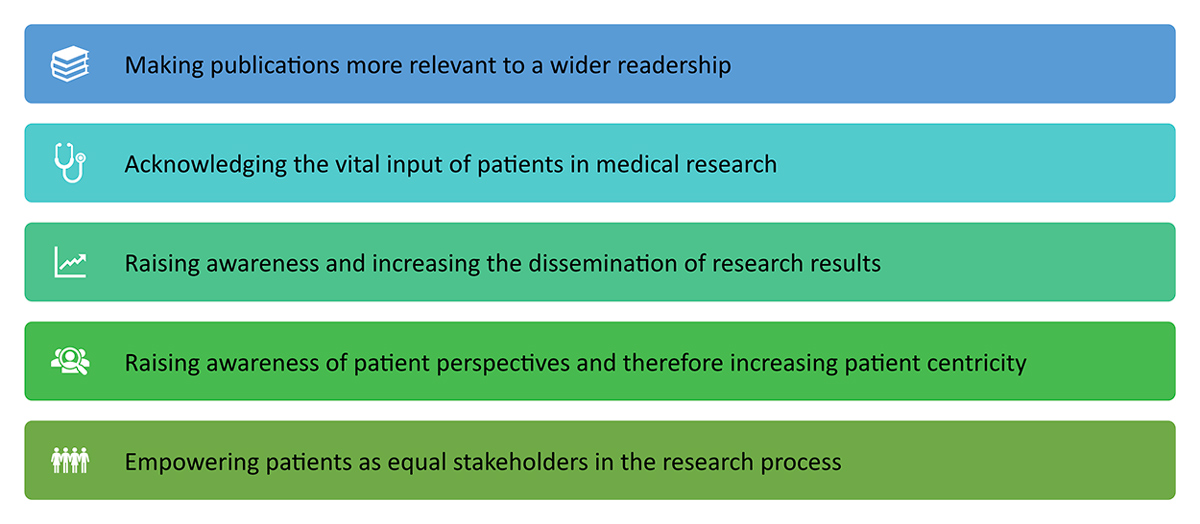Research Involvement and Engagement, BMC
atients are becoming increasingly involved in medical publications. This includes taking an active role in the publication process, as well as reading peer-reviewed journals that have traditionally considered their audience to be healthcare specialists. As academic publishers have traditionally worked with researchers and professionals across academia and industry, they are less familiar with working with patient communities or members of the public. This has led to a need to develop new ways of working that are appropriate both for the publishers, and for the patients and patient representatives with whom they are engaging.
Patients as Authors
Journals have policies on the criteria that individuals need to fulfill to qualify for authorship; many use the International Committee of Medical Journal Editors (ICJME) authorship criteria. Patient involvement throughout the drug-development process is increasing, encouraged by both the US Food and Drug Administration and the European Medicines Agency. This in turn increases the potential for them to meet these authorship criteria and become co-authors when the resulting research is published. Patient-authored original research can be very influential, in terms of downloads, citations, and Altmetrics, such as this recent piece on a rare disorder.
Patients are also contributing to article types beyond the publication of original research, including perspective-style articles and narrative reviews discussing the patient experience. Some examples of this include the BMJ Patient and Public Perspectives, the Plain Language Summary of Publication articles from the Future Science Group (which can include a patient perspective section), peer-reviewed podcast articles, Adis Patient-Physician Perspective articles, and narrative reviews.
The benefits of patient authorship on medical publications are numerous (Figure 1).

Patients as Reviewers
Patients as Editors
The journal Research Involvement and Engagement provides a notable example, as the role of co-editor-in-chief is held by a patient (co-author of this article, Richard Stephens), which, given the journal’s remit to develop the evidence base to inform the practice of patient and public involvement in research, is an extremely valuable and ground-breaking step.
Patients as Readers
Effective dissemination is needed to reach this new audience, beyond the traditional indexing services such as PubMed that are used by academia and industry to find content. In this context, publication on accessible platforms and the use of social media to disseminate content is extremely valuable.
In addition, publishers are adopting publication enhancements that extend the reach of articles and increase comprehension and accessibility (for example, PLS, infographics, and videos). Article enhancements are also often very “shareable” via social media.
New article types and features (such as PLS) and specialist journals (including the previously mentioned Research Involvement and Engagement, along with others such as the Journal of Patient Experience) are also emerging that are specifically geared toward patient engagement and readership.
Potential Barriers to Patient Involvement in Publications—and Some Solutions!
As mentioned, fulfilling journal authorship criteria, designed with traditional academic and industry authors in mind, can be challenging for patients, and publishers’ interpretation of these criteria as they apply to patients can also be variable, leading to exclusion. Some guidance is available to help with this, and encouraging patient involvement early in the research process is also a valuable aid to these criteria being met.
Publishing software programs (such as manuscript submission and peer-review systems) can be challenging to navigate even for those familiar with using them, and they have not been designed with patient authors, reviewers, or editors in mind. Simplification of these systems where possible would be beneficial to all, and any future updates should consider the variety of potential users of these systems.
Further barriers to patient involvement were discussed in Part A of this article series and include awareness among the patient community of what opportunities exist, juggling demands of disease management, job or family commitments, lack of confidence/encouragement to work alongside industry and academic authors, and privacy concerns.
Discussion of patient engagement among publishers themselves is increasing, and work is being done to make publishing processes more accessible. However, to benefit fully from this, it will be vital for these opportunities to be widely shared via as many channels as possible (to patient organizations, via conferences involving patients, on social media, and more), and on a continuing basis.
What’s Next?
Hidden in plain sight? Identifying patient-authored publications
Guidance for BMJ Patient and Public Reviewers
The accessibility of materials for patients with rare diseases
Plain Language Summary of Good Publication Practice Guideline
Patient Focused Medicines Development Patient Engagement Management Suite

